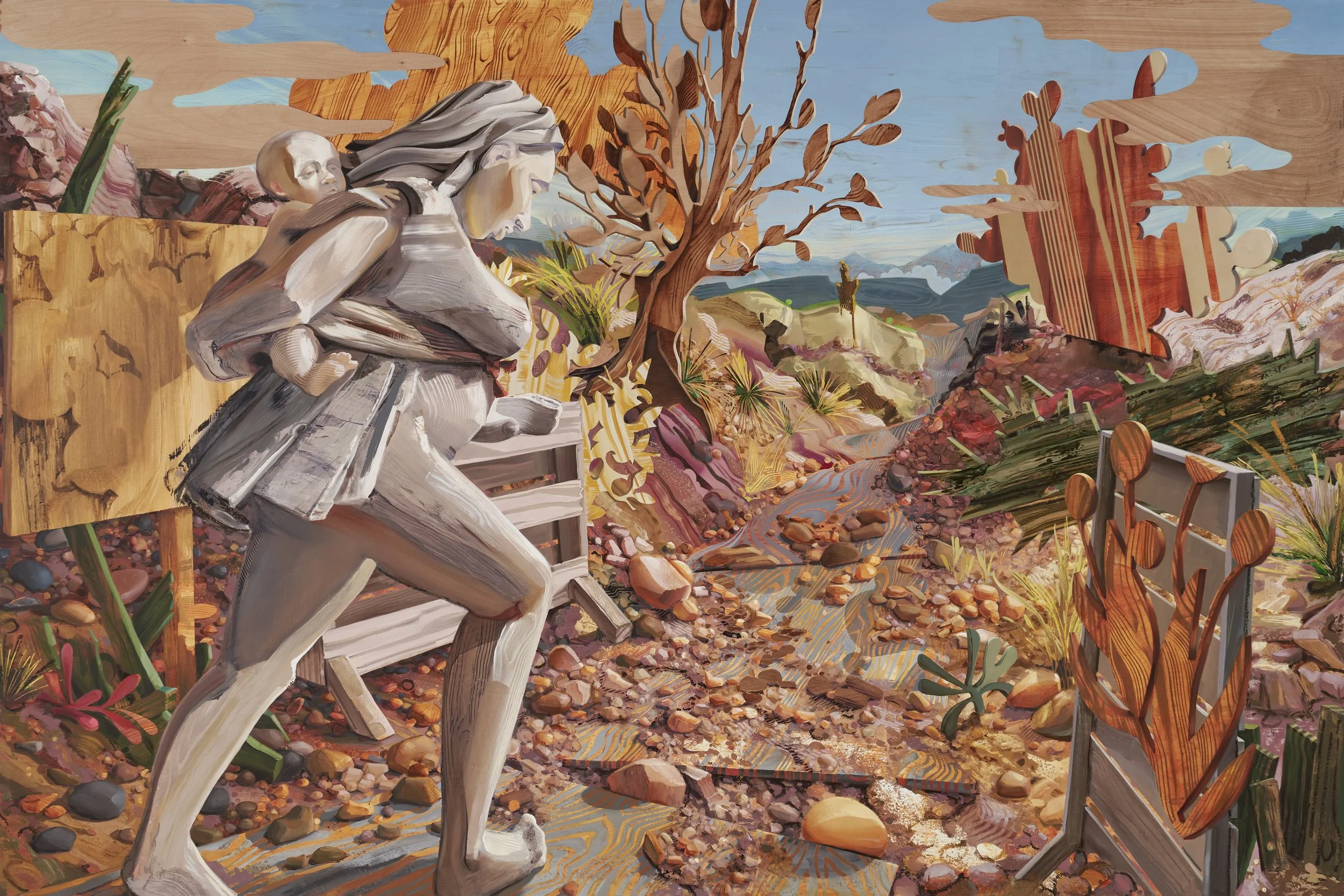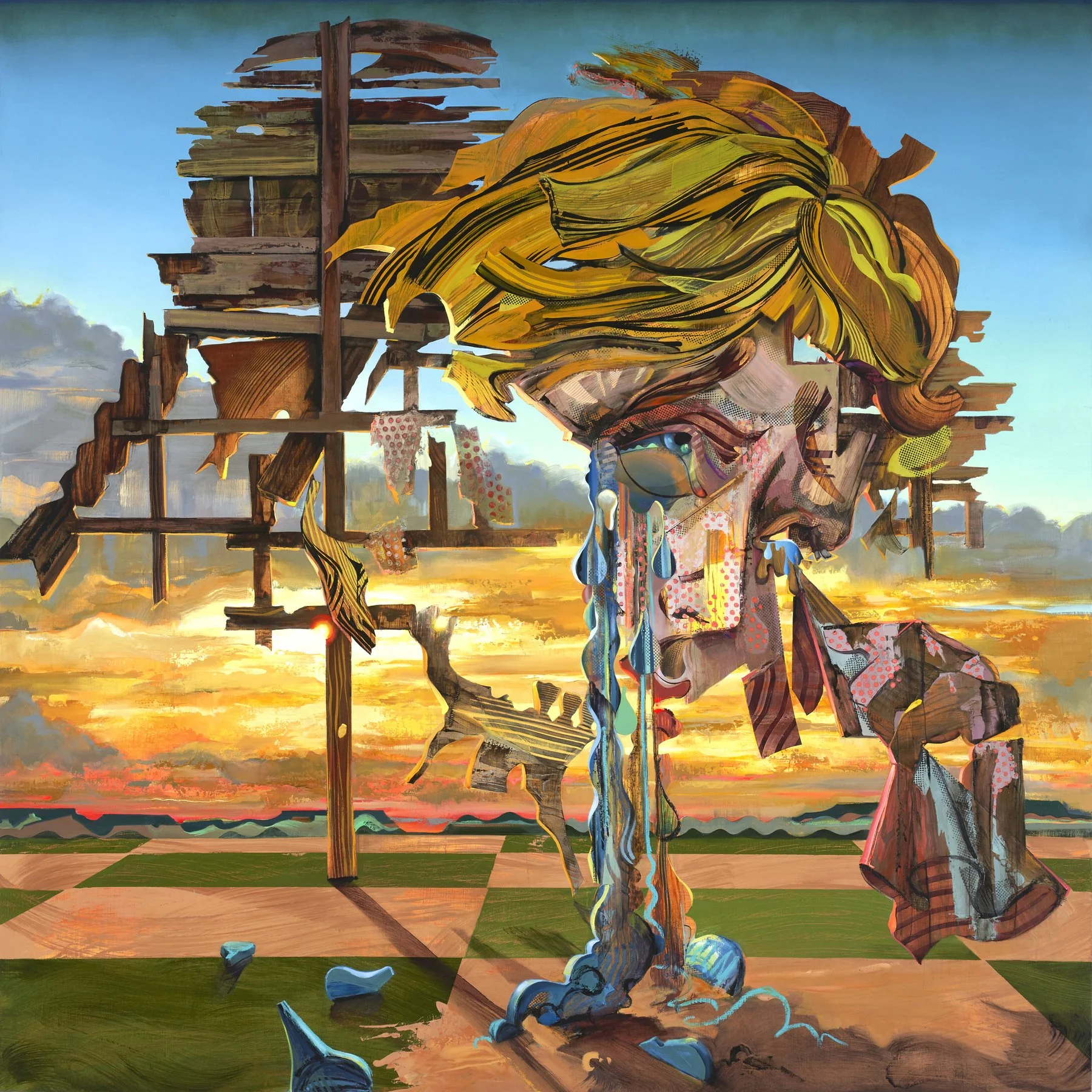Essay & Paintings
Fallen World
Essay By Sarah Courteau
Paintings by Margaret Curtis
Margaret Curtis
The Forest Was Rebuilt with Scrap and Ply, 2023.
Oil and ash on panel, 72 x 96 inches. Courtesy of the artist and Tracey Morgan Gallery.
The day before fall, I sit in the backyard amid the lush wreckage of summer’s end. By the patio, my eighteen-month-old daughter is pulling soft caterpillar heads from stems of fountain grass touched with gold. Grapevines dangle unripe buttons of fruit down the back fence. Erupting from the grass are dandelions big as ferns, their puffs long ago snatched by the wind. Around the yard’s perimeter, weeds as high as my thighs exalt with abandon. The dog bounds by like Pepé Le Pew in search of love, disappearing into a feathery wave of crabgrass that flanks the north fence.
My daughter rocks over to a blueberry bush on legs still unsure of their anchor. Her stubby fingers search for more of the purple berries she plucked earlier this summer. I recall her delight upon discovering their tang, which the bland blueberries from the grocery store lack.
“No more,” I say. “They’re all gone. The season is done.” She looks at me with the glazed eyes of a junkie and goes on sorting through leaves tipped with the first licks of autumn fire.
I feel an outsized sense of pride. In the Bronx, a New York City borough latticed with highways and packed with housing, I have given her the pleasure of foraging for berries. As a girl growing up in the Ozark Mountains, I braved yellow jackets, snakes, and briars to bring home buckets of sun-warmed fruit from berry patches tucked away in the hills. I cannot give her those long afternoons of solo berry picking that instilled in me an early confidence that natural perils can be navigated. But at least this runaway yard in the Bronx offers her a glimpse of nature’s fecund power.
At the end of May, my husband ruptured his Achilles tendon. He was the primary mower of our lawn, a gendered division of labor we settled on early in our marriage. I’m hopeless at anything mechanical and, more to the point, I didn’t want to be a direct party to the casual sadomasochism of suburban lawn maintenance. He good-naturedly volunteered to shoulder the burden. But after his injury, I did try to keep the grass trimmed, pumping the gas mower’s choke and yanking the engine to life with the viciousness the long cord requires. How hard could it be? Our yard is tiny—perhaps a thousand square feet.
As the summer wore on, though, I grew overwhelmed with caring for my daughter, for my temporarily one-legged husband, and for my own self. In July, I gave up and let everything grow. It felt bad. And then it felt good. The yard quickly reverted to a raggedness that brought my soul a secret comfort. Under the skin of the semi-suburban semi-housewife that I found myself inhabiting still lives the child raised on a farm where grazing animals did the mowing.
Once I got over the shame of neglecting our lawn in a neighborhood where sterile topiaries dominate, I marveled at the bounty and variety of flora that had taken root. When we’d bought our house three years earlier, every inch of the yard had been entombed in concrete. This is not uncommon in the Bronx. Some homeowners pave their yards to avoid the hassle of lawn maintenance or to carve out precious off-street parking spots, but for many, it is a desperate gambit to seal out the water that is flooding basements and garages as climate change brings heavier rains. The concretization of city neighborhoods is another example of the tragedy of the commons. Our thousand square feet of yard sown with natural grass can potentially absorb about 620 gallons per inch of rainfall. If paved over, all that water flows into already overburdened streets and sewers.
After my husband and I took possession of the house, our first order of business was to hire landscapers to break up the cement and haul in topsoil. We had big dreams for this yard when we moved in. Then along came a baby, a new job, and, yes, a badly flooded basement. We haven’t managed to do much more than sprinkle grass seed and plant blueberry bushes. Everything else growing here sprouted from a seed carried by wind, water, or birds.
This haphazard plot, circumscribed by a glaringly ugly high white vinyl fence that we will never get around to tearing out, will form my daughter’s first impressions of Mother Nature. As she points skyward at a plane floating toward the runways at LaGuardia Airport six miles away, I find myself calculating all the ways in which her relationship with the natural world is already so different from mine.
I spent my early years on a hilltop farm where wilderness stalked open spaces—pastures, yard, garden, barn, corrals, ponds, horse paths. Thickets of buckbrush resplendent with red berries in winter, thorny locust saplings, stands of fragrant sassafras, vicious green briars that hooked clothing and hands, tree-of-heaven that seemed to shoot up overnight—all this life encroached wherever there was the least opportunity. My father fought back with chainsaw and brush hog, but the effort required to keep nature at bay meant that any ground whose openness wasn’t essential to man or beast was left alone.
Pounding the whispering dust of a path worn by hooves with my own bare feet, or scampering over weathered sandstone kissed with lichen, or scaling a wild persimmon to taste the chalky sour of half-ripe fruit, I reveled in the sense that the world was made for me. I have carried a love of wildness through my life. My parents did not intentionally bestow this inheritance any more than I consciously received it. But it is mine nonetheless.
What I am passing on to my daughter is very different. This Bronx yard is a treasure and a privilege in our urban landscape. Here my daughter can revel in the feel of her bare feet in the grass. From her bedroom window, she can trace the changing seasons in the oak tree going scarlet in front of our house. The wind in the giant pine rising from a neighboring backyard muffles traffic noise. But there is no avoiding that we live in a crowded city. Her every brush with nature is mediated by that reality. Parks are lovely, but there are rules and paths and trash and, bless them, benches. Everywhere she looks, my little girl can see that the world is not hers alone. It is made for others, too. This isn’t a bad way to live. The world would be a better place if more of us treated it like a commons rather than a private gift. And yet, I feel a sense of loss for my daughter.
As I watch her stalking the dog through our yard, I take comfort that at least she has this little patch of open land filled in by nature’s hand. Curious about what’s taken root here, I snap pictures of the cast of green characters and upload them to an app called Planta. It identifies nearly all of them as invasive species: white mulberry (Asia), fountain grass (Africa), crabgrass (Eurasia). Looking around, I realize that the only plants I’m sure belong here are those blueberry bushes, which I researched before purchasing to make sure they were native to the Northeast. Our yard threw a party this summer, and the only guests who showed up were bad seeds.
In the middle of the yard, I spy a splash of color dipping and waving. I wander toward it, in need of some uplift. On a spear of Virginia copperleaf, I discover two monarch butterflies locked in coitus. The larger male clings to a leaf, his brilliant orange wings spread wide open, only his top left wing covered by greenery. The female backs up to join her abdomen to his, her wings demurely folded to show their paler orange undersides. The distinctive monarch pattern of black veins is starker and more intricate on her smaller wings. On this tangled ground, they have found peace for their union.
Delighted, I google monarch breeding habits, and discover that the miracle I’m witnessing is a disaster. Monarchs typically enter a state of suspended reproduction in the autumn to conserve energy for their southward migration. The butterflies on my lawn are supposed to be heading toward Mexico for a chaste honeymoon before flying north to mate in the spring. But tempted by the unseasonably warm weather and my wild yard, they are getting hot and heavy ahead of schedule. Odds are that these two love bugs, depleted by several hours of mating, will die before they make it south.
My yard isn’t the homage to resilience that I want it to be for my daughter. It is a study in nature’s disruptions. I stand amid plants that shouldn’t be growing in this soil, watching butterflies mate who should be hundreds of miles south by now. I’ve been anxious about the wrong inheritance. It’s easier to worry that I’m depriving my daughter of a wild Ozark childhood than to acknowledge that I cannot offer her even this tiny patch of ground without asterisks, caveats, apologies.
She toddles up to me. She is the most perfect child in the history of children, her short legs larded in baby fat, her hair hanging in soft rings, a slight underbite jutting her chin forward in permanent stubbornness. She offers me something plucked from the ground that looks suspiciously like a dried dog turd, as if to say, “Hors d’oeuvre, Madame?” Before I can snatch it, she pops it into her mouth.
The sun, gentled to amber with the lengthening of the days, bathes us both in late afternoon warmth. The breeze is soft on our skin. The giant pine above us whispers of all it can see from its great height in a language only other trees can understand. The dog rolls in the tall grass. The butterflies wave on their stalk, oblivious to their ecological miscues.
We live in a fallen world.
But it is the only one we have.
I cannot ask my daughter to carry in her heart all the grief of a lost world. It is too heavy. I can describe to her a time when snow blanketed the ground in New York every winter, but I might as well be telling her a fairy tale. Nor will she mourn the snakes and the fireflies of my own youth spent in the Ozark Mountains—both populations that are on the wane. We adopt the world we are born into. Hers will be different from mine, harsher, less hospitable to humans and to many of the plant and animal species we love. But it will be beautiful. Still. Full of miracles. Still.
When Adam and Eve ate of the apple and were banished from the Garden of Eden, what story did their children tell of the world they inherited? Did they look around at the sky, the animals, the rocks and rivers, and that damned apple tree and see only what they had lost? Was the world marred irredeemably by the mistakes of their parents? Or did they behold each day, ripe as it was with sin and suffering, as the gift that it still was?
To pass on our fallen world to my daughter is a sin that cannot be redeemed. But so is denying her its pleasures.
I look down again at the mating monarchs. I notice that the male’s top left wing isn’t obscured by a leaf, as I had thought. It is missing altogether. A serration of orange teeth edges the chitinous layer where scales and color should be. Unable to undertake the long journey south, he has made his final stand here, in our yard, in an act of beautiful futility.
I call to my daughter: “Come, look.”
Sarah Courteau is an Ozarks-born writer living in the Bronx. Her fiction and essays have appeared in the Oxford American, the New York Times, the Washington Post, Witness, and Dark Yonder, among other publications. A graduate of Yale University and the University of Iowa’s nonfiction MFA program, she was the 2022–2023 Pen Parentis Writing Fellow.
Margaret Curtis is a feminist artist whose exuberantly painted, multi-layered narrative paintings address power dynamics on both the individual and societal level. Reviews and features of Curtis’ work have appeared in Art Forum, the New York Times, Art in America, Art News, and New Art Examiner, among others. Her work is in public and private collections throughout the United States.
About the Paintings
For the past seven years, the artist Margaret Curtis has been studying and documenting wildfire burn scars. Based in North Carolina and New Mexico, she has studied and hiked through forests ravaged by fires in the American Southwest. Whether domestic interiors or landscapes, her recent works, a selection of which appear on the preceding pages, are all set against a backdrop of the climate emergency.
After the catastrophic 2022 Hermit’s Peak fire in northern New Mexico, Curtis photographed the devastation and gathered ash to grind into oil paints with which she created The Forest Was Rebuilt with Scrap and Ply. In Pink Stripe, in which a woman carries a child up a dry creek bed surrounded by plywood cutouts, signs, replicas, and debris pieced together like intricate jewel-toned inlay. The ersatz, post-apocalyptic world she is entering is beautiful in its own right. With their stage-set terrain of false fronts and facades, these canvases embody our heavy-handed influence on delicate ecosystems, and speak to our urge to fashion beauty out of staggering loss.
Margaret Curtis
Pink Stripe, 2021.
Oil on panel, 48 x 72 inches.
Courtesy of the artist and Tracey Morgan Gallery.
Margaret Curtis
Collapse, 2023.
Oil and ash on panel, 60 x 60 inches.
Courtesy of the artist and Tracey Morgan Gallery.
Margaret Curtis, Portrait of My Anxiety (Burning Wallpaper), 2021. Oil on panel, 48 x 36 inches. Courtesy of the artist and Tracey Morgan Gallery.



